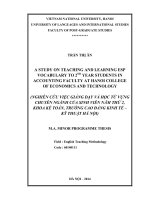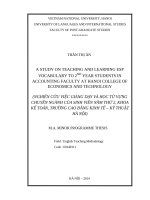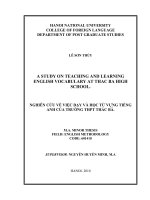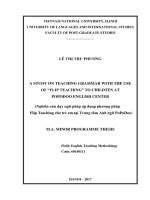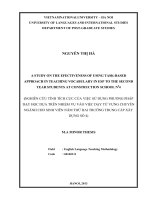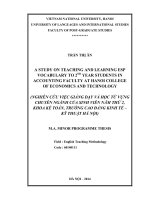(Luận văn thạc sĩ) a study on teaching and learning ESP vocabulary to 2nd year students in accounting faculty at hanoi college of economics and technology
Bạn đang xem bản rút gọn của tài liệu. Xem và tải ngay bản đầy đủ của tài liệu tại đây (713.5 KB, 71 trang )
VIETNAM NATIONAL UNIVERSITY, HANOI
UNIVERSITY OF LANGUAGES AND INTERNATIONAL STUDIES
FACULTY OF POST-GRADUATE STUDIES
**********
TRẦN THỊ ÂN
A STUDY ON TEACHING AND LEARNING ESP
VOCABULARY TO 2ND YEAR STUDENTS IN
ACCOUNTING FACULTY AT HANOI COLLEGE
OF ECONOMICS AND TECHNOLOGY
(NGHIÊN CỨU VIỆC GIẢNG DẠY VÀ HỌC TỪ VỰNG
CHUYÊN NGÀNH CỦA SINH VIÊN NĂM THỨ 2,
KHOA KẾ TOÁN, TRƯỜNG CAO ĐẲNG KINH TẾ –
KỸ THUẬT HÀ NỘI)
M.A. MINOR PROGRAMME THESIS
Field : English Teaching Methodology
Code : 60140111
HÀ NỘI – 2014
VIETNAM NATIONAL UNIVERSITY, HANOI
UNIVERSITY OF LANGUAGES AND INTERNATIONAL STUDIES
FACULTY OF POST-GRADUATE STUDIES
**********
TRẦN THỊ ÂN
A STUDY ON TEACHING AND LEARNING ESP
VOCABULARY TO 2ND YEAR STUDENTS IN
ACCOUNTING FACULTY AT HANOI COLLEGE
OF ECONOMICS AND TECHNOLOGY
Ơ
(NGHIÊN CỨU VIỆC GIẢNG DẠY VÀ HỌC TỪ VỰNG
CHUYÊN NGÀNH CỦA SINH VIÊN NĂM THỨ 2,
KHOA KẾ TOÁN, TRƯỜNG CAO ĐẲNG KINH TẾ –
KỸ THUẬT HÀ NỘI)
M.A. MINOR PROGRAMME THESIS
Field: English Teaching Methodology
Code: 60140111
Supervisor: Dr. Kiều Thị Thu Hương
HÀ NỘI – 2014
DECLARATION
I hereby, certify the thesis entitled “A study on teaching and learning ESP
vocabulary to 2nd year students in Accounting Faculty at Hanoi College of
Economics and Technology” is the result of my own research for the Minor
Degree of Master of Arts at University of Language and International Studies,
Vietnam National University, Hanoi. The thesis has not been submitted for any
degree at any other universities or institutions. I agree that the origin of my
paper deposited in the library can be accessible for the purposes of study and
research.
Hanoi, 2014
Trần Thị Ân
i
ACKNOWLEDGEMENTS
In completion of this study, first of all, I would like to express my sincere deep
gratitude to my supervisor Dr. Kieu Thi Thu Huong, without whom this thesis could
not have been completed. She gave me not only reliable guidelines and
knowledgeable suggestions but also continual encouragement to accomplish this
study.
I am indebted to Assoc. Prof. Dr. Le Hung Tien – the chair of Faculty of PostGraduate Studies for his valuable and interesting course in Research Methodology,
which provides me with essential techniques to complete this thesis.
My deep appreciation goes to all staff, teachers and members at Faculty of PostGraduate Studies of University of Languages and International Studies, Vietnam
National University for their work and services. Especially, I am grateful to the
librarians who supplied me with a lot of materials.
My thanks are also extended to all my students, my colleagues at Hanoi College
of Economics and Technology, and all the people who have assisted my research
work.
Last but not least, my special thanks go to my parents and my friends, without
their encouragement my dream of pursuing this study would not have been possible.
ii
ABSTRACT
This study has been conducted to investigate difficulties which both the ESP
teachers and the learners at Hanoi College of Economics and Technology have to
face during their teaching and learning Accounting vocabulary of ESP course.
The subjects of the study are six ESP teachers and fifty second-year students
of Accounting major. The data have been collected by a combination of quantitative
and qualitative methods, including the use of questionnaires and informal
interviews. The study confirms that both the ESP teachers and the learners face
difficulties in teaching and learning ESP vocabulary. There are three main problems
existing in the ESP vocabulary teaching and learning process: (i) teachers’ lack ESP
knowledge and various teaching techniques; (ii) students’ traditional and passive
vocabulary learning strategies and their limited GE vocabulary and (iii) large-sized
classes.
Based on the findings, some recommendations have been proposed. ESP
teachers should improve their ESP knowledge, apply flexible and various
techniques in teaching ESP vocabulary. Students should enhance their GE
knowledge and develop effective strategies of vocabulary learning. Finally, the size
of classes should be reduced.
iii
TABLE OF CONTENTS
Declaration------------------------------------------------------------------------------------ i
Acknowledgements -------------------------------------------------------------------------- ii
Abstract --------------------------------------------------------------------------------------- iii
Table of contents ---------------------------------------------------------------------------- iv
List of abbreviations ------------------------------------------------------------------------- vii
List of charts and tables ------------------------------------------------------------------- viii
List of figures -------------------------------------------------------------------------------- ix
PART I: INTRODUCTION -------------------------------------------------------------- 1
1. Statement of the problem ---------------------------------------------------------------- 1
2. Aims of the study ------------------------------------------------------------------------- 2
3. Research questions ----------------------------------------------------------------------- 2
4. Scope of the study ------------------------------------------------------------------------ 2
5. Methods of the study --------------------------------------------------------------------- 2
6. Design of the study ----------------------------------------------------------------------- 2
PART II: DEVELOPMENT ------------------------------------------------------------ 4
CHAPTER 1: LITERATURE REVIEW ---------------------------------------------- 4
1.1. Overview of ESP ---------------------------------------------------------------------- 4
1.1.1. Definition of ESP -------------------------------------------------------------- 4
1.1.2. Classification of ESP ---------------------------------------------------------- 5
1.1.3. Characteristics of ESP -------------------------------------------------------- 7
1.2. ESP Vocabulary ----------------------------------------------------------------------- 9
1.2.1. Definition of ESP vocabulary ------------------------------------------------ 9
1.2.2. Terminology -------------------------------------------------------------------- 9
iv
1.2.2.1. Definition of terminology -------------------------------------------- 9
1.2.2.2. Features of terminology ---------------------------------------------- 10
1.3. Teaching and learning ESP vocabulary ------------------------------------------ 10
1.3.1. Teaching ESP vocabulary ---------------------------------------------------- 10
1.3.1.1. Dudley-Evans and St John’s viewpoint ---------------------------- 10
1.3.1.2. Hutchinson and Waters’s viewpoint -------------------------------- 11
1.3.2. Learning ESP vocabulary----------------------------------------------------- 12
1.4. Roles of ESP teachers ---------------------------------------------------------------- 14
1.4.1. ESP practitioners as teachers ------------------------------------------------- 14
1.4.2. ESP practitioners as course designers and material providers -------------- 14
1.4.3. ESP practitioners as researchers --------------------------------------------- 15
1.4.4. ESP practitioners as collaborators ------------------------------------------- 15
1.4.5. ESP practitioners as evaluators ---------------------------------------------- 15
1.5. Difficulties in teaching and learning ESP vocabulary ------------------------ 16
1.5.1. Students at different levels --------------------------------------------------- 16
1.5.2. Teachers’ lack of basic specialized knowledge---------------------------- 16
1.5.3. Teaching and learning materials and conditions -------------------------- 17
1.6. Previous studies on teaching and learning ESP vocabulary ----------------- 17
1.7. Summary-------------------------------------------------------------------------------- 18
CHAPTER 2: METHODOLOGY ------------------------------------------------------ 19
2.1. Context of the study ------------------------------------------------------------------ 19
2.1.1. Course book -------------------------------------------------------------------- 19
2.1.2. Students and their background ----------------------------------------------- 20
2.1.3. Teachers and teaching methods ---------------------------------------------- 21
v
2.2. Subjects of the study------------------------------------------------------------------ 22
2.3. Data collection instruments --------------------------------------------------------- 22
2.3.1. Questionnaires ----------------------------------------------------------------- 22
2.3.2. Informal interviews for teachers --------------------------------------------- 24
2.4. Data collection procedure ----------------------------------------------------------- 24
CHAPTER 3: DATA ANALYSIS, MAJOR FINDINGS AND SUGGESTED
SOLUTIONS -------------------------------------------------------------------------------- 25
3.1. Data analysis --------------------------------------------------------------------------- 25
3.1.1. Questionnaire for teachers ---------------------------------------------------- 25
3.1.2. Questionnaire for students ---------------------------------------------------- 33
3.2. Major findings ------------------------------------------------------------------------- 41
3.2.1. Teachers’ difficulties in teaching ESP vocabulary ------------------------ 41
3.2.1.1. Lack of specialized knowledge -------------------------------------- 41
3.2.1.2. Lack of various teaching techniques -------------------------------- 41
3.2.2. Students’ difficulties in learning ESP vocabulary------------------------- 41
3.2.2.1. Lack of effective strategies for learning ESP vocabulary ------- 41
3.2.2.2. Lack of GE vocabulary ---------------------------------------------- 42
3.2.3. The contextual problem ------------------------------------------------------- 43
3.3. Suggested solutions ------------------------------------------------------------------- 43
3.3.1. Solutions to teaching ESP vocabulary -------------------------------------- 43
3.3.1.1. Improving the teachers’ ESP knowledge -------------------------- 43
3.3.1.2. Improving teacher's methodology and techniques in teaching
vocabulary ---------------------------------------------------------------------- 44
3.3.2. Solutions to learning ESP vocabulary -------------------------------------- 45
3.3.2.1. Enhancing the necessary GE knowledge -------------------------- 45
vi
3.3.2.2. Developing effective strategies of vocabulary learning -------- 45
3.3.3. Solutions to the contextual problem----------------------------------------- 46
PART III: CONCLUSION --------------------------------------------------------------- 47
1. Summary of the findings and solutions ------------------------------------------------ 47
2. Limitations of the study ------------------------------------------------------------------ 48
3. Suggestions for further research -------------------------------------------------------- 48
REFERENCES ----------------------------------------------------------------------------- 49
APPENDICES ------------------------------------------------------------------------------ I
Appendix 1 ----------------------------------------------------------------------------------- I
Appendix 2 --------------------------------------------------------------------------------- IV
vii
LISTS OF ABBREVIATIONS
ESP:
English for Specific Purposes
EBE:
English for Business and Economics
ESS:
English for Social Science
EST:
English for Science and Technology
EAP:
English for Academic Purposes
EOP:
English for Occupational Purposes
EGP
English for General Purposes
GE:
General English
HCET:
Hanoi College of Economics and Technology
AE:
Accounting English
T1:
Teacher 1
T2:
Teacher 2
T3:
Teacher 3
viii
LISTS OF CHARTS AND TABLES
Chart 1: Teachers’ attitudes towards teaching ESP vocabulary in the course book
Chart 2: Teachers’ evaluation about students’ learning ESP vocabulary
Chart 3: Teachers’ difficulties in teaching ESP vocabulary
Chart 4: Teachers’ techniques in presenting new words
Chart 5: Teachers’ recommendations to overcome your difficulties in teaching ESP
vocabulary
Chart 6: Students’ English competence
Chart 7: The purposes of learning ESP vocabulary
Chart 8: Students’ difficulties in learning ESP vocabulary in the course book
Chart 9: Problems have influenced students’ motivation and interest
Chart 10: Students’ solutions when meeting a new word
Table 1: The purposes of teaching ESP vocabulary
Table 2: Teachers’ ways to ask students to practice vocabulary
Table 3: Teachers’ frequency of consolidation activities
Table 4: The students’ difficulties in learning ESP vocabulary
Table 5: Students’ ways of learning new ESP words
Table 6: Students’ favourite ways of new lexical item explanation
ix
LISTS OF FIGURES
Figure 1: ESP Classification by experience (Robinson, 1991, cited in Dudley-Evans
and St John, 1998:6)
Figure 2: Types of ESP (Hutchinson and Waters, 1987: 16)
Figure 3: ESP Classification by professional area (Dudley-Evans and St John,
1998:6)
x
PART I: INTRODUCTION
1. Statement of the problem
English has nowadays become the language of international communication. As
Phillipson points out,
English has a dominant position in science, technology, medicine, and computers;
in research, books, periodicals, and software; in transnational business, trade,
shipping, and aviation; in diplomacy and international organizations; in mass
media entertainment, news agencies, and journalism; in youth culture and sport; in
education system, as the most widely learnt foreign language.
Phillipson (1992: 6)
Therefore, students have more opportunities to build up their knowledge by reading
a variety of materials in English. Also, they have more chances to perform qualified
work abroad. Obviously, in order to do these activities, students need to have
certain knowledge of English for Specific Purposes (ESP) vocabulary related to
their subjects or fields. This ESP vocabulary will help them adjust to their working
environment and meet requirements of their future jobs.
Vocabulary is an inseparable part of any teaching syllabus. However, “Teaching
vocabulary especially in ESP course is becoming a challenge for English Language
Teachers” (Xhaferi, 2010: 231). Working as ESP teachers at Hanoi College of
Economics and Technology (HCET), my colleagues and I face many difficulties in
teaching ESP vocabulary, such as lack of specialized knowledge and terminologies.
Also, learning ESP vocabulary is a very difficult task for our second-year students
of Accounting. They have limited knowledge of vocabulary and English grammar.
They do not actively study new words and build up their vocabulary. Their poor
vocabulary results in their bad results each term.
Realising above problems, the teachers of English of HCET want to do something
to change the ways of teaching and learning vocabulary in order to improve the
students’ learning effectiveness to help them succeed in their future jobs. Therefore,
1
I have decided to conduct a research to find out main difficulties in teaching and
learning English vocabulary of accounting at HCET. Then, I would like to suggest
some solutions to overcome these difficulties.
2. Aims of the study
The study is aimed at finding difficulties that ESP teachers and learners at HCET
are facing in teaching and learning ESP vocabulary and suggesting some solutions
to teaching and learning ESP vocabulary.
3. Research questions
1. What difficulties do HCET’s teachers have in teaching ESP vocabulary?
2. What major difficulties do accounting students face in learning ESP
vocabulary at HCET?
3. What are solutions to improving Accounting English vocabulary teaching and
learning at HCET?
4. Scope of the study
The study has limited itself to the investigation of difficulties in teaching and
learning ESP vocabulary in the course book “English for Finance” for the students
who major in Accounting at Hanoi College of Economics and Technology. The
suggested solutions are also provided to help improve teaching and learning of ESP
vocabulary at HCET.
5. Methods of the study
The research is carried out by using both qualitative and quantitative methods. The
data collection instruments are survey questionnaires and informal interviews. The
questionnaires are designed for the teachers and students to get information on the
difficulties they have in teaching and learning ESP vocabulary. The informal
interview is designed for teachers to get more information to support the study and
solutions to these problems.
6. Design of the study
The study includes three parts:
2
Part one is the Introduction of the study, which states the problem, the research
questions, aims, scope, methods and the design of the whole paper.
Part two is the Development, which consists of three chapters. Chapter one
presents the theoretical background related to the topic. Chapter two describes the
context and the methodology of the study in detail. Chapter three includes data
analysis, findings and suggested solutions for better teaching and learning ESP
vocabulary at HCET.
Part three is the Conclusion, which summarizes major findings of the investigation,
provides suggested solutions, limitations and suggestions for further studies.
3
PART II: DEVELOPMENT
CHAPTER 1: LITERATURE REVIEW
In this chapter, the author addresses some theoretical issues, such as overview of
ESP, ESP vocabulary, teaching and learning ESP vocabulary, roles of ESP teachers
and difficulties in teaching ESP vocabulary.
1.1.
Overview of ESP
1.1.1. Definition of ESP
ESP, which stands for “English for Specific Purposes”, has become an essential part
in “the Teaching of English as a Foreign or Second Language movement” (Howatt,
1984 cited in Dudley-Evans and St John, 1998: 1). To understand the term ESP
correctly, we will ponder on certain following clarifications. There have been a lot
of attempts to define ESP.
Hutchinson and Waters (1987:19) define ESP as “…an approach to language
teaching in which all decisions as to content and method are based on the learners’
reason for learning”. They confirm that ESP must be seen as an approach not as a
product. ESP is neither a particular kind of language or methodology, nor includes a
particular type of teaching material. Teaching ESP does not mean teaching a special
form of the language. It is an approach to language teaching, which is based on
specific and apparent learners’ needs and interests.
Strevens (1988: 1) states: “ESP is a particular cause of the general category of
special purpose language teaching". Robinson’s definition of ESP (1991: 3) is
based on two criteria: 1) ESP is normally ‘goal-directed’, and 2) ESP courses
develop from a needs analysis which aims to specify what exactly it is that students
have to do through the medium of English, and a number of characteristics which
explain that ESP courses are generally constrained by a “limited time period” in
which their objectives have to be achieved and are taught to “adults” in
4
“homogenous classes” in terms of the work or specialist studies that students are
involved in (cited in Dudley-Evans and St John, 1998: 3).
Munby (1978: 2) says that ESP courses are those of which the syllabus and
materials must be designed and determined on the base of the prior analysis of the
communication needs of the learner. Learners usually have different needs and
interests, which would have an important influence on their motivation and attitude
to learn.
The above definitions stated at different time periods by different authors obviously
show that the growth of ESP is a combination of the expansion of demand for
English to suit particular needs and developments in the fields of linguistics and
educational psychology (Hutchinson and Waters, 1987:19). In other words, any ESP
course must be based on learners’ needs.
1.1.2. Classification of ESP
There are many types of ESP, which are classified in different ways. Traditionally,
ESP can be divided into two main groups according to when they take place:
English for Academic Purposes (EAP) and English for Occupational Purposes
(EOP). Robinson (1991) shows the distinction between these two areas in the
following tree diagram.
Pre-experience
EOP
Simultaneous/ in-service
Post-experience
Pre-study
In-study
ESP
For study in a specific discipline
EEP/EAP
Post-study
Independent
As a school subject
Integrated
Figure 1: ESP Classification by experience
(Robinson, 1991, cited in Dudley-Evans and St John, 1998:6)
5
Kennedy and Bolitho define the two types of ESP:
English for Occupational Purposes (EOP) is taught in a situation in which learners
need to use English as a part of their work or profession. Meanwhile, English for
Academic Purposes (EAP) is taught generally within educational institutions to
students needing English in their studies.
Kennedy and Bolitho (1984: 4)
From the above diagram, we can see that the ESP course depends on whether it can
be classified as EOP or EAP. This division of ESP is vital because “they will affect
the degree of specificity that is appropriate to the course” (Dudley-Evans and St
John, 1998:6). However, Hutchinson and Water (1987: 16) do note that it is not “a
clear-cut distinction” because people can work and study at the same time, “it is
also likely that in many cases the language learnt for immediate use in a study
environment will be used later when the student takes up, or returns a job".
In “the Tree of ELT” (Hutchinson and Waters, 1987:16), ESP is broken down into
three branches: English for Science and Technology (EST), English for Business
and Economics (EBE), and English for Social Studies (ESS). Each of these subject
areas is further divided into two sub-branches: English for Academic Purposes
(EAP) and English for Occupational Purposes (EOP). An example of EOP for the
EBE branch is “English for Secretaries” whereas an example of EAP for the EBE
branch is “English for Economics”.
ESP
EST
EAP
English
for
Medical
Study
EBE
EOP
English
for
Techini
-cians
EAP
English
for
Economics
ESS
EOP
EAP
English
for
Secreta
-ries
English
for
Psychol
-ogy
EOP
English
for
Teaching
Figure 2: Types of ESP (Hutchinson and Waters, 1987: 16)
6
Another division of ESP divides EAP and EOP according to “discipline or
professional area” in the following way:
English for Specific Purposes
English for Academic Purposes
English
for
(Academic)
Science &
Technology
English
For
(Academic)
Medical
Purposes
English
For
(Academic)
Legal
Purposes
English for Occupational Purposes
English
For
Management
English for
Professional Purposes
English for
Vocational Purposes
English
For
Medical
Purposes
Pre-
Finance and
Economics
English
For
Business
Purposes
Vocational
English
Figure 3: ESP Classification by professional area
(Dudley-Evans and St John, 1998:6)
From figure 3, it is obvious that ESP which is taught to students majoring in
Accounting at Hanoi College of Economics and Technology belongs to English for
Management Finance and Economics and it is a type of English for Academic
Purposes.
In brief, various types of ESP are like an overall picture to help ESP teachers
choose teaching materials and classroom activities, design or/and adapt an
appropriate ESP course for their target students.
1.1.3. Characteristics of ESP
Strevens (1988) makes a distinction between four “absolute characteristics” and
two “variable characteristics” of ESP. He distinguishes two kinds of
characteristics.
7
Vocation
-al
English
* Absolute characteristics:
-
ESP is designed to meet specified needs of the learners;
-
ESP is related in content (that is in its themes and topics) to particular disciplines,
semantics, occupations and activities;
-
ESP is centred on the language appropriate to those activities in syntax, lexis,
discourse, semantics and so on, and analysis of the discourse;
-
ESP is in contrast with “General English”.
* Variable characteristics:
-
ESP may be restricted as to the learning skills to be learned (for example reading
only);
-
ESP may not be taught according to any pre-ordained methodology.
(cited in Dudley-Evans and St John, 1998: 3)
Then, ten years later, Dudley-Evans and St John (1998: 4-5) identified ESP with
three absolute characteristics and four variable characteristics.
* Absolute characteristics:
-
ESP is designed to meet specific needs of learners;
-
ESP makes use of the underlying methodology and activities of the disciplines it
serves;
-
ESP is centered on the language (grammar, lexis, and register), skills, discourse
and genres appropriate to these activities.
* Variable characteristics:
-
ESP may be related to or designed for specific disciplines;
-
ESP may use, in specific teaching situations, a different methodology from that of
general English;
-
ESP is likely to be designed for adult learners, either at tertiary level institution or
in a professional work situation. IT could, however, be used for learners at
secondary school levels;
-
ESP is generally designed for intermediate or advanced students. Most ESP courses
assume basic knowledge of the language system, but it can be used with beginners.
8
Thus, the absolute and variable characteristics of ESP determine what ESP is and
what ESP is not. ESP should be seen as simple as an “approach” to teaching, based
on the analysis of learners’ needs and their own personal knowledge of using
English for real communication.
1.2.
ESP vocabulary
1.2.1. Definition of ESP vocabulary
Ur (1996) states:
Vocabulary is the words we teach in the foreign language. However, a new item of
vocabulary may be more than a single word: a compound of two or three words or
multi-word idioms.
Ur (1996: 60)
In other words, vocabulary is the total number of all the words that a language
possesses, including a single word or multi-word idioms whose meaning can be
understood in the sentence, or in the context.
English vocabulary, in general, includes grammatical words, basic lexical words
and auxiliaries. In addition, “special lexical items appear in most professions, and
every field has special vocabulary to cover abstract concepts” (Hatch and Brown,
1995: 312). Nation (2001: 198) defines ESP vocabulary as a word or a group of words
used as a special lexical unit in a specific field with specific meaning to the field.
1.2.2. Terminology
1.2.2.1.
Definition of terminology
Linguists have come up with various definitions of terminology. In Longman
Dictionary of Applied Linguistics (1985: 290), terminology is defined as “the
special lexical which occur in a particular discipline”. Cabré (1999) insists:
Terminology is not an end itself, but addresses social needs and attempts to optimize
communication among specialists and professionals by providing assistance either directly
or to translator or to committees concerned with the standardization of a language.
Cabré (1999: 10-12)
9
Meanwhile, Nguyễn Thiện Giáp (1985) says:
Terminology, which is understood as a special linguistic unit of a language consists
of word and fixed phrase that provide definitions of objectives that belong to a
particular scientific area.
Nguyễn Thiện Giáp (1985: 308)
From Wikipedia, the free encyclopedia, terminology is defined as the study of terms
and their use. Terms are words and compound words that are used in a specialized
field or a branch of study.
In brief, unlike ordinary words, terminology or a set of terms are regarded as
scientific words and each term denotes a concept in a particular field such as
economics, biology, chemistry, and so on.
1.2.2.2.
Features of terminology
It is commonly known that most of the layers of vocabularies have their own
features and are used in certain situations by particular groups of people. That is
also applied to terminology. Nguyễn Thiện Giáp (1985) in his book Từ vựng học
Việt Nam or Vietnamese Lexicology has pointed out three main characteristics of
terminology. The first is accuracy, which says that a concept in terminology must
be clear and exact. An accurate term should not make the reader misunderstand the
concept it expresses with another. The second is systematization. This means
terminology of a specific profession should include terms that are closely related to
each other and reflect a system of concepts of the profession. The last characteristic
of terminology is internationality. With respect to this feature, terminology denotes
common scientific concepts shared and equally understood by speakers of different
countries and different cultures.
1.3.
Teaching and learning ESP vocabulary
1.3.1. Teaching ESP vocabulary
1.3.1.1. Dudley-Evans and St John’s viewpoint
10
Dudley-Evans and St John (1998: 83) state that teaching vocabulary in ESP has
similar principles to teaching English for General Purposes (EGP). The only
distinction that should be made is between the vocabulary for comprehension and
the one for production. They explain that in comprehension, the meaning is deduced
from the context and the structure of the actual word. Meanwhile, for production
purposes, storage and retrieval are the most important.
Also, in the book named “Developments in ESP: A multi-disciplinary approach”,
Dudley-Evans and St John (1998: 83) point out that the ESP teacher is not
responsible for teaching technical vocabulary. Instead, he/ she should check if
learners have understood technical vocabulary that appears as carrier content for an
exercise. From our understanding, they mean that ESP teachers should make the
learners understand vocabulary in context, not just look at individual words.
Understanding and being able to use the vocabulary and structures that they learn in
a meaning full context reinforces what is taught and increases their motivation.
A suitable approach for teaching ESP vocabulary is the lexical approach. This
approach is very useful in teaching ESP (Kavaliauskienë and Janulevièienë, 2000).
Most learners equate “vocabulary” with “words”, and there is a tendency among
learners to translate any professional text word-for-word, i.e., they usually try to
simplify most lexical phrases to separate words. This ESP teaching methodology is
also mentioned by Dudley-Evans and St John (1998). They say:
… [W]hen learners have a limited need for English in certain predictable
situations, the learning of key lexical phrases may provide a very quick road to the
proficiency required of that situation…
Dudley-Evans and St John (1998: 86)
1.3.1.2. Hutchinson and Waters’s viewpoint
According to Hutchinson and Waters (1987: 53), “All courses are based on a
perceived need of some sort” and “There is always an identifiable need of some
sorts”. Moreover, “…it is not so much the nature of the need which distinguishes
11
the ESP from the General course but rather the awareness of a need” to
communicate in English. These sentences mean that the ESP courses must be based
on the learners’ needs and the more important thing is the target needs what the
learner needs to do in the target situation, including “necessities”, “lacks” and
“wants”. Necessities is understood as “…what the learner needs to know in order to
function effectively in the target situation” (Hutchinson and Waters, 1987: 55)
However, it is not enough. An ESP teacher needs to know learners’ lacks and wants
to design a suitable ESP course because these aspects influence learners’ motivation
that is highly important in the learning and teaching process.
In short, when teachers make a decision on what ESP vocabulary to teach, they
should take the target needs into consideration. Accordingly, the ESP teacher plays
an important role in teaching and learning vocabulary as Gairns and Redman (1986)
say:
If the student does not perceive the vocabulary input to be useful it will be difficult
to engage his interest and so effective learning of everything else will also be
reduced.
Gairns and Redman (1986: 60)
1.3.2. Learning ESP vocabulary
Vocabulary is generally thought to be one of the most important language elements.
Wilkins (1972: 111-112) writes, “...while without grammar very little can be
conveyed, without vocabulary nothing can be conveyed”. Without sufficient
vocabulary people cannot understand others or express their own ideas. McCarthy
(1990) points out:
No matter how well the student learns grammar, no matter how successfully the
sounds of L2 are mastered, without words to express a wider range of meanings,
communication in an L2 just cannot happen in any meaningful way.
McCarthy (1990: viii)
Obviously, the importance of vocabulary cannot be deniable.
12
However, from our teaching experience we can say that students face difficulties
while learning new English words, especially ESP words because they are lowfrequency words and are not encountered very often. Schmitt (2000) emphasizes:
The object of vocabulary learning is to transfer lexical information from short-term
memory, where it resides during the process of manipulating language, to
permanent long-term memory.
Schmitt (2000: 131)
ESP courses are designed around students’ needs based on their field of study. The
goal is to strengthen students’ proficiency and help them to get ready to cope with
everyday situations and deal with professionals in many fields such as: Business,
engineering, medicine, education, IT, etc. In order to develop an ability to learn new
vocabulary, especially technical vocabulary in learning ESP, students should
become aware of the importance of language learning strategies.
In his research into vocabulary teaching and learning, Nation (2001: 133-134) has
broached four strands which applied to all aspects of language in general and to
vocabulary learning in particular. The first is “learning from meaning-focused
input”. This strand includes learning vocabulary from listening and reading. The
learners of English should have known ninety-eight percent of the occurring words,
and the rest will be conjectured from the contexts and will not prevent
‘comprehension of the text’. The second is “deliberate learning”. This strand (formfocused instruction, language-focused learning or language study) comprises
‘paying deliberate attention to language features such as sounds, spelling,
vocabulary, grammar, or discourse that are presented out of context’. The clearest
technique is ‘learning new vocabulary by memorizing their first language
translation’. The third is “learning from meaning-focused output”. This strand
consists of learning vocabulary ‘through speaking and writing where the learners’
main attention is on communication messages’. Using the ‘productive skills as
sources of vocabulary learning’ can enhance learning. And the last strand is
“fluency development”. The fluency development strand of a language course
13
